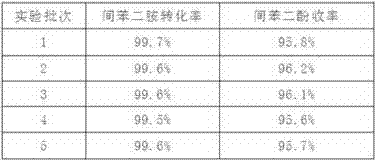Preparation method of supported solid acid catalyst for hydrolysis of m-phenylenediamine
A technology of solid acid catalyst and m-phenylenediamine, which is applied in the preparation of organic compounds, chemical instruments and methods, physical/chemical process catalysts, etc., and can solve the problems of high equipment material requirements, tedious follow-up treatment process, and corrosive reaction system Strong and other problems, to achieve the effect of inhibiting coking of polymerization, excellent chemical stability, and easy control of loading capacity
- Summary
- Abstract
- Description
- Claims
- Application Information
AI Technical Summary
Problems solved by technology
Method used
Image
Examples
Embodiment 1
[0018] Example 1: A method for preparing a supported solid acid catalyst for the hydrolysis of m-phenylenediamine, which specifically includes the following steps:
[0019] (1) Using a hydrochloric acid solution with a mass concentration of 20%, the contrast surface area is 1200m 2 / g of nutshell charcoal powder is heated and refluxed. The washed charcoal powder is washed with deionized water until the pH remains unchanged, and then added with a 20% mass concentration nitric acid solution for heating and refluxing. The heating temperature is 65°C and the reflux time is 10h , The treated activated carbon powder is washed with deionized water until the pH remains unchanged, and dried in vacuum for use;
[0020] (2) Prepare 100g of phosphotungstic acid solution with a mass concentration of 10%, add 20g of charcoal powder from the husk obtained in step (1), stir and immerse for 15h at low speed, and filter and depressurize the carbon-supported heteropolyacid catalyst after immersion Af...
Embodiment 2
[0022] Embodiment 2: A preparation method of a supported solid acid catalyst for the hydrolysis of m-phenylenediamine, which specifically includes the following steps:
[0023] (1) Using a sulfuric acid solution with a mass concentration of 40%, the contrast surface area is 1800m 2 / g of husk charcoal powder is heated and refluxed. The washed charcoal powder is washed with deionized water until the pH remains unchanged, and then 30% hydrogen peroxide is added for heating and reflux treatment. The heating temperature is 80℃, and the reflux time is 5h. The treated activated carbon powder is washed with deionized water until the pH remains unchanged, and dried in vacuum for use;
[0024] (2) Prepare 90g of phosphomolybdic acid solution with 25% mass concentration, add 35g of nutshell charcoal powder obtained by step (1), stir and immerse for 30h at low speed, after immersion, the carbon-supported heteropolyacid catalyst is filtered and decompressed After drying, it is transferred to a...
Embodiment 3
[0028] Example 3: A preparation method of a supported solid acid catalyst for the hydrolysis of m-phenylenediamine, which specifically includes the following steps:
[0029] (1) Using 30% hydrochloric acid solution, the contrast surface area is 1500m 2 / g of husk charcoal powder is heated and refluxed. The washed charcoal powder is washed with deionized water until the pH remains unchanged, and then a 30% mass concentration ammonium persulfate solution is added for heating and reflux treatment. The heating temperature is 72℃, and the reflux time For 8 hours, the treated activated carbon powder is washed with deionized water until the pH does not change, and vacuum dried for use;
[0030] (2) Prepare 200 g of phosphotungstic acid solution with a mass concentration of 15%, add about 80 g of the charcoal powder from the husk obtained in step (1), stir and immerse for 22 hours at low speed, and after the end of immersion, the carbon-supported heteropoly acid catalyst is filtered and red...
PUM
| Property | Measurement | Unit |
|---|---|---|
| Specific surface area | aaaaa | aaaaa |
| Specific surface area | aaaaa | aaaaa |
| Total pore volume | aaaaa | aaaaa |
Abstract
Description
Claims
Application Information
 Login to View More
Login to View More - R&D
- Intellectual Property
- Life Sciences
- Materials
- Tech Scout
- Unparalleled Data Quality
- Higher Quality Content
- 60% Fewer Hallucinations
Browse by: Latest US Patents, China's latest patents, Technical Efficacy Thesaurus, Application Domain, Technology Topic, Popular Technical Reports.
© 2025 PatSnap. All rights reserved.Legal|Privacy policy|Modern Slavery Act Transparency Statement|Sitemap|About US| Contact US: help@patsnap.com

